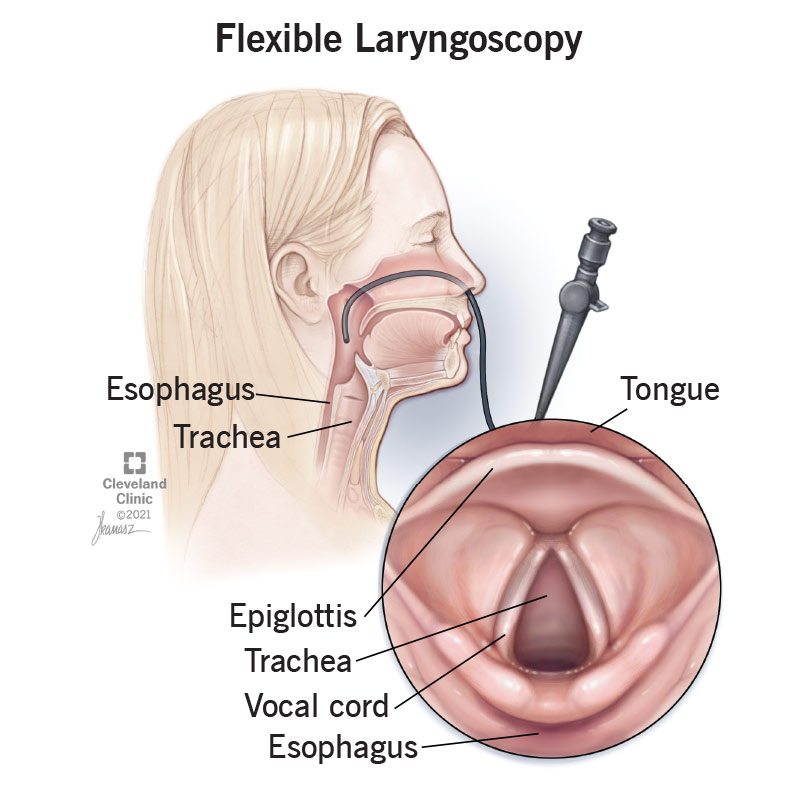A laryngoscopy (lair-in-GAHS-kuh-pee) is a test healthcare providers perform to examine your larynx (voice box). They perform this test with a laryngoscope, a thin tube with lights, a lens and video cameras that help them to look closely at your larynx. Laryngoscopes may have tools your provider can use to remove tissue from your larynx.
Advertisement
Cleveland Clinic is a non-profit academic medical center. Advertising on our site helps support our mission. We do not endorse non-Cleveland Clinic products or services. Policy

A laryngoscopy is a procedure healthcare providers use to examine your larynx (voice box). This is performed with a laryngoscope, a thin tube with a light, lens and a video camera that helps providers look closely at your larynx. Providers may do laryngoscopies in a clinic office or as surgery in an operating room.
Advertisement
Cleveland Clinic is a non-profit academic medical center. Advertising on our site helps support our mission. We do not endorse non-Cleveland Clinic products or services. Policy
Your larynx is located between your throat and your trachea (windpipe). Your larynx houses your vocal cords (vocal folds), which enable you to speak and sing. Your epiglottis sits on top of your larynx. Your epiglottis is a flap that closes when you eat or drink so items intended for your esophagus (food pipe) don’t end up in your larynx or in your airway. When people talk about something going down the wrong pipe, the pipe they’re talking about is your larynx.
Your healthcare provider may recommend a laryngoscopy to diagnose problems like dysphonia (hoarseness) or to diagnose laryngitis. They may also do laryngoscopies to diagnose more serious conditions such as laryngeal cancer.
Healthcare providers called otolaryngologist-head and neck surgeons perform laryngoscopies. An otolaryngologist is a provider and surgeon who specializes in treating conditions that affect your ear, nose, throat and head and neck. Otolaryngologists may perform laryngoscopies in a clinic office or in an operating room.
Your healthcare provider will consider your specific situation when deciding which type of laryngoscopy they’ll use. You may have your laryngoscopy in a clinic office or as a surgical procedure. For example, your provider may decide you should have a surgical laryngoscopy in an operating room. This is a direct laryngoscopy. Providers typically do direct laryngoscopies following in-office flexible laryngoscopies. Direct laryngoscopies may be done along with biopsies or other surgical procedures.
Advertisement
If you’re having a surgical laryngoscopy, you’ll receive general anesthesia. Your provider will talk to you about getting ready for your procedure:
You don’t need to do anything to prepare for a laryngoscopy done in a clinic office.
Surgical laryngoscopies and clinic office laryngoscopies have different processes.
Your provider will use a special laryngoscope that’s inserted through your mouth. Because you had general anesthesia, you won’t feel anything.
Different things happen depending on whether you had a surgical laryngoscopy or one done in an office clinic.
It’s rare to have any complications with in-office flexible laryngoscopy. Please talk to your provider about any specific concerns you may have. Direct laryngoscopies done in the operating room are usually safe, but there can be complications, including:
Biopsies are procedures to remove tissue for examination. Providers retrieve a tiny piece of throat tissue, using a tiny tool that looks like a miniature tweezer. They pass the tool through a laryngoscope to retrieve tissue. Providers may do biopsies as part of a direct laryngoscopy done in an operating room. In some circumstances, they may do biopsies in the clinic (office).
Advertisement
Endoscopies and laryngoscopies are both tools healthcare providers use to look inside your body. In both cases, providers use tubes equipped with lights, a lens and, sometimes, video cameras. The difference is a laryngoscope is specifically designed to view your larynx.
Results from in-office flexible laryngoscopy are immediate. But if providers obtain a tissue sample as part of a biopsy or if they do a culture, it may take several days for the results to come back. This is more common with direct laryngoscopy in the operating room. Ask your provider when you can expect to have test results.
Typically, laryngoscopies are safe tests without significant risks. But you should call your provider if:
There are several reasons why your healthcare provider may recommend you have a laryngoscopy. You may have a persistent sore throat. Your voice might sound hoarse and isn't improving. Or, you may have several symptoms that indicate something is affecting your larynx. Regardless of why you’re having a laryngoscopy, your provider will explain the process from start to finish. If there’s something you don’t understand, ask your provider. They’ll be glad to answer your questions so you feel comfortable about the test.
Advertisement
You don’t have to live with voice box problems. Cleveland Clinic has the larynx disorder treatments you need.

Last reviewed on 04/22/2022.
Learn more about the Health Library and our editorial process.